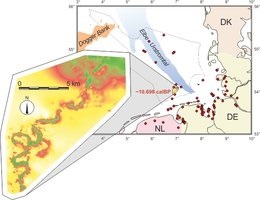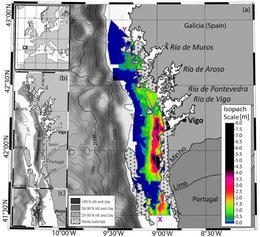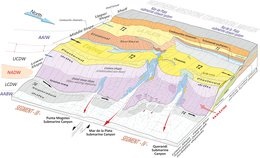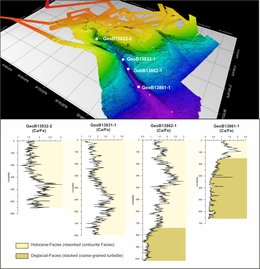SD2
SD2 - Climatic control on large-scale sedimentary structures
A. Bartholomä, M. Elvert, A. Freiwald, D.A. Hepp, S. Kasten, H. Keil, H. Lantzsch, H. Müller, F. Oberle, M. Strasser, V. Spieß, T. v. Dobeneck
The sedimentary systems of continental shelves and slopes host various large-scale depositional and erosional features whose formation processes are controlled by sediment flux, hydrodynamic conditions, sea level, and local topography (Nittrouer et al. 2007). All of these parameters commonly interact with each other in a complex way and react strongly to climatic conditions.
The effect of climatic forcing on locally confined depocenters (shelf mud belts, shelf sand fields, lowstand deltas, slope contourites), elongated depressions (paleo-valleys, slope canyons), and characteristic erosional features (furrows, scars) will be studied by interdisciplinary approaches. Major advances supporting such studies are provided through the MeBo system, which has already been successfully applied for SD studies at the Uruguay margin, and by the newly developed GOST system providing in-situ geotechnical data.
SD2 Key Hypotheses
Our understanding of paleo- and modern sediment dynamics related to transgressive scenarios is limited due to the often discontinuous nature of open-shelf sedimentary records. Paleo-valleys formed during sea-level lowstands offer a great preservation potential for early transgressional sedimentary sequences (Green, 2009). Using seismic, sedimentological, geotechnical and numerical modeling approaches, transgressional sedimentary sequences will be investigated following in the wake of the last deglacial sea-level rise (Vink et al. 2007). Understanding the development of shelf (re-)organization during transgressions is also of societal relevance. Regions of interest are the Elbe/Weser paleo-valley and its tributaries in the central North Sea, and the continental shelf off Uruguay. Deciphering the formation history of shelf depositional and erosional elements is essential to properly interpreting their sensitive records of environmental variability.

Buried valley of a postglacial river in the southern North Sea. This valley is a former tributary of the Elbe/Weser paleo-valley.
Locally confined sediment depocenters and erosional features in shelf systems reflect the variability of hydrodynamic and climatic conditions (Hanebuth et al. 2011). Dislocation and re-organisation of such depocenters (by sediment supply, current-topography interaction, relocation of transport pathways, sea level) leads to a reorganization of the entire shelf system (Lantzsch et al. 2010) including sedimentary links from shelf to slope (Bender et al. 2012). Evolution of these elements will be assessed by high-resolution seismo-acoustic mapping and ground-truthing (sedimentology, geochemistry) combined with numerical sediment-transport modeling. We are calculating volumes and masses of sediment depocenter successions and integrate them into a shelf-wide, LGM-to-present numerical sediment-distribution model to unravel the dominant environmental forces and to extract responses within the shelf-slope system in a prognostic way. Regions of interest are the shelves off SE South America, Iberia, and the North Sea.

Volumetric budget calculation of sediment and carbon storage and export for a late Holocene mid-shelf mudbelt system (NW Iberia).
Contouritic depositional systems are generated by long-lasting contour-parallel currents whose strengths and boundaries are forced by variations in climate and sea level. Their architecture is also controlled by the interaction of ocean currents with local factors such as sediment supply and bottom topography, and by events such as abyssal storms (Rebesco and Camerlenghi, 2008). The relative impacts of these forces on depositional geometries will be assessed. Additionally, processes triggering the sediment instability frequently observed within contouritic deposits will be investigated. Focusing on the current-dominated slope off Argentina/Uruguay, seismo-acoustic, sedimentological, geochemical, geotechnical and transport/depositional modeling approaches will be used to decipher the relevant long- and short-term processes.

3-D Morpho-sedimentary map of the contouritic depositional system around the Mar del Plata Canyon (off Argentina).
Canyon systems operate either as primary conduits for sediments from the continental margin to the deep sea or as major sediment sinks. Sea-level changes control the sediment delivery by changing the shelf configuration and by influencing the dynamics of bottom currents, and therefore their interaction with the canyon topography (Henrich et al. 2009). The type and volume of material available and the sediment transport mode are linked to the climatic regime. In particular, variations in the frequency and volume of turbidite successions will be explored in the context of regional paleoceanographic (contour-currents) and paleoclimatic changes. We will apply geophysical, geotechnical, sedimentological (MeBo drilling) and geochemical methods to the study of canyon systems off SE South America and NW Africa.

Map of the Mar del Plata Canyon with locations of studied cores (top) and the distribution of reworked contouritic facies and coarse-grained turbiditic facies in the cores (bottom).
